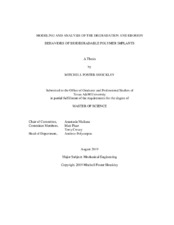Modeling and Analysis of the Degradation and Erosion Behaviors of Biodegradable Polymer Implants
Abstract
Biodegradable polymers have been used for a variety of biomedical devices since the middle of the 20th century. The researched applications have ranged from dissolvable sutures to, in more recent years, implantable scaffolds. The projected benefits of these devices come from the need for implant removal after the tissue has healed. For example, cardiovascular stents often need to be removed due to the risk of thrombosis or arterial overgrowth from prolonged implantation. In this study, the degradation and erosion behaviors of biodegradable polymeric implants is modeled and analyzed. For this work, initially dry Poly(lactic-co-glycolic acid) (PLGA) structures of varying complex geometries are examined. Constitutive equations and numerical algorithms are created to model the resulting time-dependent changes in local fluid concentrations, molecular weight loss, and monomer concentrations. This is done by taking advantage of MATLAB, a computational software. Complex geometries of multi-scale morphological features are discretized by combining several polygonal slices that capture key features of the body. Local changes in fluid concentrations, molecular weights, and monomer concentrations are presented and used to predict the degradation and erosion behaviors of polymeric implants. As the erosion takes place, the mass, volume, and geometry of the body also change. For this study, the simplified geometry of a PLGA cylinder is used to calibrate the model parameters. A realistic stent design, perforated cylinder, and indented cube are among the complex geometries modeled with the calibrated parameters.
These results provide proof-of-concept for the constitutive equations and give insight into both the macroscopic and local behaviors of bulk and surface erosions. This study shows that geometry has a significant effect upon the modes of macroscopic erosion and yields further understanding how localized modes of erosion can differ from the overall body.
Subject
PolymerPolymers
Biodegradable
Degradable
Hydrolysis
Hydrolytic
Scission
Erosion
Degradation
PLGA
Citation
Shockley, Mitchell Foster (2019). Modeling and Analysis of the Degradation and Erosion Behaviors of Biodegradable Polymer Implants. Master's thesis, Texas A&M University. Available electronically from https : / /hdl .handle .net /1969 .1 /186564.


